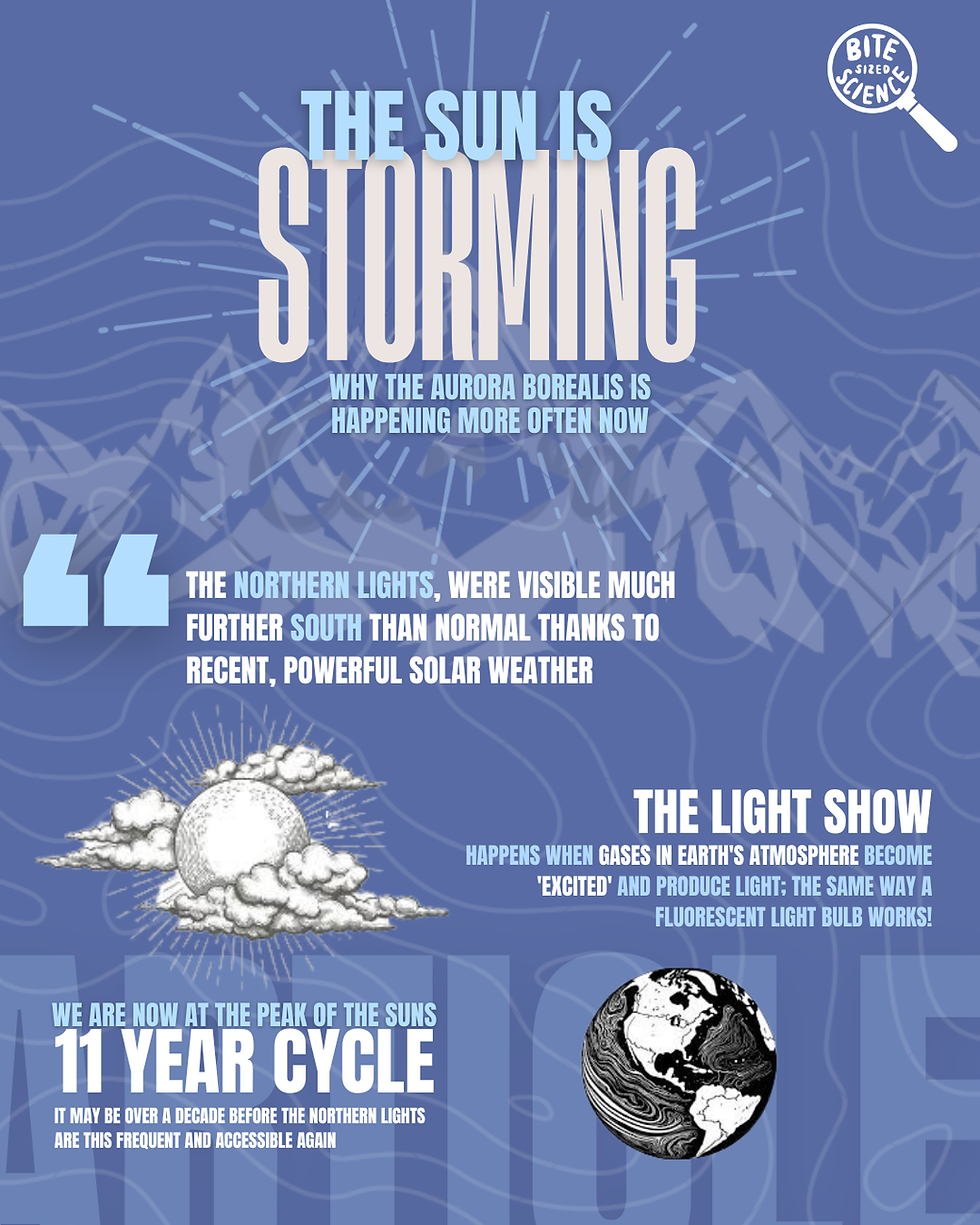Do the Northern Lights Happen More Often Now: The Impact of Solar Storms on Earth and Our Technology.
- Bite Sized Science

- Nov 4
- 4 min read

Written By: Ezra Sussman
Graphics By: Sulaiman Azif Razeen
Weather doesn’t just exist here on Earth; it exists on the sun too! In the past week, you may have heard (or even seen) that the Aurora Borealis, also known as the Northern Lights, were visible much further south than normal.1 This is due to the weather from the sun, directly influences patterns in the Earth’s atmosphere.2
There are serval types of solar storms. Coronal mass ejections and solar flares are the main ones that impact the Earth.3 Solar flares are releases of light and other forms of radiation from the Sun’s surface, whereas coronal mass ejections are releases of electrified gas and plasma, the fourth state of matter.3,4 Sometimes, these come hurling out of the Sun in our direction. Fortunately, the Earth is mostly protected from these solar events by a magnetic field, which exists because the hot metal inside the planet acts like a giant magnet .3 Part of what the field does is pull the magnetically charged matter from the sun towards the North and South Poles. This means that when bursts of energy from the solar storms hit the planet, they have a greater chance of interacting with the atmosphere as they approach the poles.5
Many of the gases that make up Earth’s atmosphere can become “excited” and produce light when they are put into a high energy state. In fact, this same mechanism is the core of how fluorescent light bulbs work!6 So, whenever solar storms hit Earth, the atmosphere can start to fluoresce. This is the core of how the Aurora Borealis, and its southern counterpart, the Aurora Australis come to be.4,5 The greater the energy coming from the sun, the further away from the poles you can be and still see them. This past week, four coronal mass ejections hit Earth in a short time frame which was why the Northern Lights were visible further south than normal.1,7 In May of 2024 there was a solar storm that made it possible to view the Aurora Borealis as far south as Mexico!8
But why might it seem like this phenomenon happens more often now than it did five or ten years ago? It’s not just reporting and social media bias.8 The sun’s weather follows an approximately 11 year long cycle. In the middle of these cycles, there is a “solar maximum” where the sun is known to be the most active, which means more solar storms and more Northern Lights.2 2024 was predicted to be the peak of this solar activity, meaning it may be over a decade before the Northern Lights are as frequent and accessible as they are now.7
But the main reason scientists pay attention to solar activity is not just the beautiful Northern Lights or to gather knowledge about the Earth’s magnetic field: it is because there is also potential for solar storms to impact human health and safety. Satellites are the main technology at risk.2-4,7 Because they are less protected by the magnetic field, they are more susceptible to damage from gusts of electrical and magnetic discharge. So much modern technology relies on these systems, from GPS to internet to weather systems. While there have been satellites in space since before the 1960’s, GPS for widespread civilian use only became available in 1988.9 This means that there have only been less than 6 full sun cycles where we can learn about how to keep satellite technology safe, and even less with them being so pivotal to society.
Additionally, sometimes solar storms are so strong that they can damage technology here on Earth. In March of 1989 there was a widespread blackout in Montreal from damage to the power grid from a geomagnetic solar storm.10 This goes to show that despite technology becoming such a large part of our lives, its place in grand scheme of things in our universe and solar system, is relatively new. While there may be an uptick in beautiful colored skies, the same forces that make that possible are also the ones we must protect ourselves from.
1. Space. 2025 [cited 2025 Oct 17]. Aurora alert! Several coronal mass ejections are racing toward Earth and could spark impressive northern lights this week. Available from: https://www.space.com/stargazing/auroras/aurora-alert-4-coronal-mass-ejections-are-racing-toward-earth-and-could-spark-impressive-northern-lights-this-week
2. Government of Canada NRC. Learning about space weather [Internet]. [cited 2025 Oct 17]. Available from: https://www.spaceweather.gc.ca/info-gen/index-en.php
3. Solar Storms and Flares - NASA Science [Internet]. 2024 [cited 2025 Oct 17]. Available from: https://science.nasa.gov/sun/solar-storms-and-flares/
4. What is Space Plasma? | Faculty of Mathematical & Physical Sciences [Internet]. [cited 2025 Oct 17]. Available from: https://www.ucl.ac.uk/mathematical-physical-sciences/mssl/research/solar-system/space-plasma-physics/what-space-plasma
5. The Science of the Northern Lights | Ontario Science Centre [Internet]. [cited 2025 Oct 17]. Available from: https://www.ontariosciencecentre.ca/science-at-home/explore-more/discover-the-northern-lights/the-science-of-the-northern-lights
6. Compact_Fluorescent_Lamps.pdf [Internet]. [cited 2025 Oct 17]. Available from: https://batch.libretexts.org/print/url=https://chem.libretexts.org/Ancillary_Materials/Exemplars_and_Case_Studies/Exemplars/Environmental_and_Green_chemistry/Compact_Fluorescent_Lamps.pdf
7. Government of Canada NRC. Zonal review and forecast [Internet]. [cited 2025 Oct 17]. Available from: https://www.spaceweather.gc.ca/forecast-prevision/short-court/zone-en.php
8. The Weather Network. 2024 [cited 2025 Oct 19]. Why are the Northern Lights so supercharged lately and how long will this last? Available from: https://www.theweathernetwork.com/en/news/science/space/science-of-space-weather-why-are-the-northern-lights-so-active
9. Sputnik [Internet]. [cited 2025 Oct 19]. Available from:
10. BBC [Internet]. [cited 2025 Oct 19]. BBC World Service - Witness History, What the 1989 solar storm did to Quebec. Available from: https://www.bbc.co.uk/programmes/w3ct4x8h



Comments